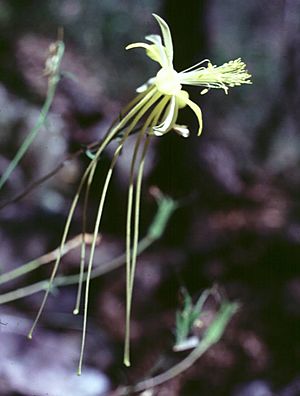Long-spur columbine facts for kids
Quick facts for kids Long-spur columbine |
|
|---|---|
 |
|
| Scientific classification | |
| Genus: |
Aquilegia
|
| Species: |
longissima
|
| Synonyms | |
|
Aquilegia coerulea f. longissima (A.Gray) Rapaics |
|
The Aquilegia longissima, also known as the long-spur columbine, is a special and rare wild flower. It is a perennial plant, meaning it lives for more than two years. You can find this unique plant growing naturally in northern Mexico, a part of Texas called Trans-Pecos, and southern Arizona.
Meet the Long-Spur Columbine
The long-spur columbine is famous for its very long "spurs." These are like long tubes that stick out from the back of the flower. They can be over 10 centimeters (about 4 inches) long! The plant also has narrow, spoon-shaped petals. These slender spurs usually hang straight down.
This flower was first described in 1883 by a scientist named Asa Gray. He noted that its super long spurs made it different from other similar flowers, like the golden columbine (Aquilegia chrysantha), which has shorter spurs.
Long-spur columbines often bloom in the fall. This happens after the "monsoon rains," which are heavy summer rains in these dry regions. You can usually find them in shady canyons. They grow near streams that sometimes dry up or on rocky slopes. These areas are often filled with oak, pine, and juniper trees.
How This Flower Gets Pollinated
Pollination is how plants make seeds. It often involves insects or other animals moving pollen from one flower to another. For flowers with very long spurs, like the long-spur columbine, special pollinators are needed. These pollinators must have long tongues to reach the nectar deep inside the spurs.
In 1883, another scientist, William Trelease, thought the giant sphinx moth (Cocytius antaeus) might be the main pollinator. This moth is very rare in west Texas. It has been seen in Big Bend National Park, where long-spur columbines grow.
However, scientists now think that other large hawkmoths are more common pollinators. These include moths from the groups Manduca and Agrius. These moths have tongues that are about 9 to 14 centimeters long. This length is perfect for reaching the nectar in the columbine's long spurs.
Mixing and Matching: Hybrid Flowers
Different types of columbine flowers can sometimes mix their genes. This process is called hybridization. It means that two different species can create a new plant that has features from both parents.
You can find some columbine plants that are "intermediate." This means their spurs are not as long as the long-spur columbine, but not as short as other types. Their spurs are usually between 7 and 9 centimeters long. These intermediate plants often look more like the common golden columbine.
One place where you can see these intermediate plants is at Cattail Falls in Big Bend National Park. The columbines growing at the bottom of the falls and along the stream bloom in the spring. But if you go further up the canyons, you will find small groups of the true long-spur columbine. These plants bloom later, in the fall, after the monsoon rains.

